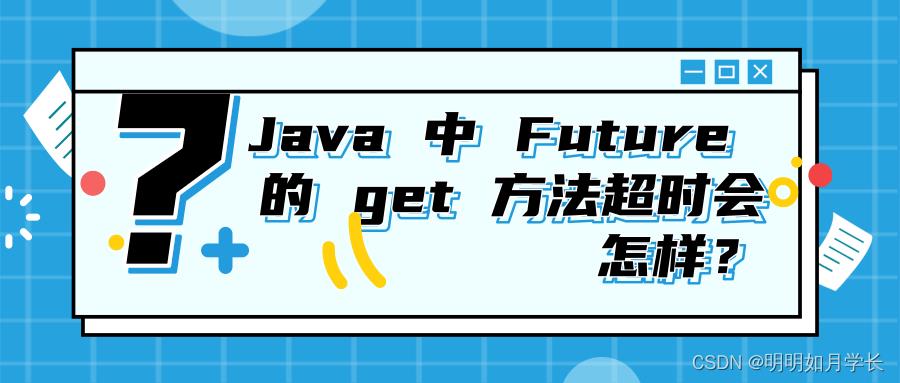Java 中 Future 的 get 方法超时会怎样?
Posted 明明如月学长
tags:
篇首语:本文由小常识网(cha138.com)小编为大家整理,主要介绍了Java 中 Future 的 get 方法超时会怎样?相关的知识,希望对你有一定的参考价值。
一、背景
很多 Java 工程师在准备面试时,会刷很多八股文,线程和线程池这一块通常会准备线程的状态、线程的创建方式,Executors 里面的一些工厂方法和为什么不推荐使用这些工厂方法,ThreadPoolExecutor 构造方法的一些参数和执行过程等。
工作中,很多人会使用线程池的 submit 方法 获取 Future 类型的返回值,然后使用 java.util.concurrent.Future#get(long, java.util.concurrent.TimeUnit) 实现“最多等多久”的效果。
但很多人对此的理解只停留在表面上,稍微问深一点点可能就懵逼了。

比如,java.util.concurrent.Future#get(long, java.util.concurrent.TimeUnit) 超时之后,当前线程会怎样?线程池里执行对应任务的线程会有怎样的表现?
如果你对这个问题没有很大的把握,说明你掌握的还不够扎实。
最常见的理解就是,“超时以后,当前线程继续执行,线程池里的对应线程中断”,真的是这样吗?
二、模拟
2.1 常见写法
下面给出一个简单的模拟案例:
package basic.thread;
import java.util.concurrent.*;
public class FutureDemo
public static void main(String[] args) throws ExecutionException, InterruptedException, TimeoutException
ExecutorService executorService = Executors.newFixedThreadPool(2);
Future<?> future = executorService.submit(() ->
try
demo();
catch (InterruptedException e)
throw new RuntimeException(e);
);
String threadName = Thread.currentThread().getName();
System.out.println(threadName + "获取的结果 -- start");
Object result = future.get(100, TimeUnit.MILLISECONDS);
System.out.println(threadName + "获取的结果 -- end :" + result);
private static String demo() throws InterruptedException
String threadName = Thread.currentThread().getName();
System.out.println(threadName + ",执行 demo -- start");
TimeUnit.SECONDS.sleep(1);
System.out.println(threadName + ",执行 demo -- end");
return "test";
输出结果:
main获取的结果 -- start
pool-1-thread-1,执行 demo -- start
Exception in thread "main" java.util.concurrent.TimeoutException
at java.util.concurrent.FutureTask.get(FutureTask.java:205)
at basic.thread.FutureDemo.main(FutureDemo.java:20)
pool-1-thread-1,执行 demo -- end
我们可以发现:当前线程会因为收到 TimeoutException 而被中断,线程池里对应的线程“却”继续执行完毕。
2.2 尝试取消
我们尝试对未完成的线程进行取消,发现 Future#cancel 有个 boolean 类型的参数。
/**
* Attempts to cancel execution of this task. This attempt will
* fail if the task has already completed, has already been cancelled,
* or could not be cancelled for some other reason. If successful,
* and this task has not started when @code cancel is called,
* this task should never run. If the task has already started,
* then the @code mayInterruptIfRunning parameter determines
* whether the thread executing this task should be interrupted in
* an attempt to stop the task.
*
* <p>After this method returns, subsequent calls to @link #isDone will
* always return @code true. Subsequent calls to @link #isCancelled
* will always return @code true if this method returned @code true.
*
* @param mayInterruptIfRunning @code true if the thread executing this
* task should be interrupted; otherwise, in-progress tasks are allowed
* to complete
* @return @code false if the task could not be cancelled,
* typically because it has already completed normally;
* @code true otherwise
*/
boolean cancel(boolean mayInterruptIfRunning);
看源码注释我们可以知道:
当设置为 true 时,正在执行的任务将被中断(interrupted);
当设置为 false 时,如果任务正在执行中,那么仍然允许任务执行完成。
2.2.1 cancel(false)
此时,为了不让主线程因为超时异常被中断,我们 try-catch 包起来。
package basic.thread;
import org.junit.platform.commons.util.ExceptionUtils;
import java.util.concurrent.*;
public class FutureDemo
public static void main(String[] args) throws ExecutionException, InterruptedException, TimeoutException
ExecutorService executorService = Executors.newFixedThreadPool(2);
Future<?> future = executorService.submit(() ->
try
demo();
catch (InterruptedException e)
throw new RuntimeException(e);
);
String threadName = Thread.currentThread().getName();
System.out.println(System.currentTimeMillis() + "," + threadName + "获取的结果 -- start");
try
Object result = future.get(100, TimeUnit.MILLISECONDS);
System.out.println(System.currentTimeMillis() + "," + threadName + "获取的结果 -- end :" + result);
catch (Exception e)
System.out.println(System.currentTimeMillis() + "," + threadName + "获取的结果异常:" + ExceptionUtils.readStackTrace(e));
future.cancel(false);
System.out.println(System.currentTimeMillis() + "," + threadName + "获取的结果 -- cancel");
private static String demo() throws InterruptedException
String threadName = Thread.currentThread().getName();
System.out.println(System.currentTimeMillis() + "," + threadName + ",执行 demo -- start");
TimeUnit.SECONDS.sleep(1);
System.out.println(System.currentTimeMillis() + "," + threadName + ",执行 demo -- end");
return "test";
结果:
1653751759233,main获取的结果 -- start
1653751759233,pool-1-thread-1,执行 demo -- start
1653751759343,main获取的结果异常:java.util.concurrent.TimeoutException
at java.util.concurrent.FutureTask.get(FutureTask.java:205)
at basic.thread.FutureDemo.main(FutureDemo.java:23)
1653751759351,main获取的结果 -- cancel
1653751760263,pool-1-thread-1,执行 demo -- end
我们发现,线程池里的对应线程在 cancel(false) 时,如果已经正在执行,则会继续执行完成。
2.2.2 cancel(true)
package basic.thread;
import org.junit.platform.commons.util.ExceptionUtils;
import java.util.concurrent.*;
public class FutureDemo
public static void main(String[] args) throws ExecutionException, InterruptedException, TimeoutException
ExecutorService executorService = Executors.newFixedThreadPool(2);
Future<?> future = executorService.submit(() ->
try
demo();
catch (InterruptedException e)
System.out.println(System.currentTimeMillis() + "," + Thread.currentThread().getName() + ", Interrupted:" + ExceptionUtils.readStackTrace(e));
throw new RuntimeException(e);
);
String threadName = Thread.currentThread().getName();
System.out.println(System.currentTimeMillis() + "," + threadName + "获取的结果 -- start");
try
Object result = future.get(100, TimeUnit.MILLISECONDS);
System.out.println(System.currentTimeMillis() + "," + threadName + "获取的结果 -- end :" + result);
catch (Exception e)
System.out.println(System.currentTimeMillis() + "," + threadName + "获取的结果异常:" + ExceptionUtils.readStackTrace(e));
future.cancel(true);
System.out.println(System.currentTimeMillis() + "," + threadName + "获取的结果 -- cancel");
private static String demo() throws InterruptedException
String threadName = Thread.currentThread().getName();
System.out.println(System.currentTimeMillis() + "," + threadName + ",执行 demo -- start");
TimeUnit.SECONDS.sleep(1);
System.out.println(System.currentTimeMillis() + "," + threadName + ",执行 demo -- end");
return "test";
执行结果:
1653752011246,main获取的结果 -- start
1653752011246,pool-1-thread-1,执行 demo -- start
1653752011347,main获取的结果异常:java.util.concurrent.TimeoutException
at java.util.concurrent.FutureTask.get(FutureTask.java:205)
at basic.thread.FutureDemo.main(FutureDemo.java:24)
1653752011363,pool-1-thread-1, Interrupted:java.lang.InterruptedException: sleep interrupted
at java.lang.Thread.sleep(Native Method)
at java.lang.Thread.sleep(Thread.java:340)
at java.util.concurrent.TimeUnit.sleep(TimeUnit.java:386)
at basic.thread.FutureDemo.demo(FutureDemo.java:36)
at basic.thread.FutureDemo.lambda$main$0(FutureDemo.java:14)
at java.util.concurrent.Executors$RunnableAdapter.call(Executors.java:511)
at java.util.concurrent.FutureTask.run(FutureTask.java:266)
at java.util.concurrent.ThreadPoolExecutor.runWorker(ThreadPoolExecutor.java:1149)
at java.util.concurrent.ThreadPoolExecutor$Worker.run(ThreadPoolExecutor.java:624)
at java.lang.Thread.run(Thread.java:748)
1653752011366,main获取的结果 -- cancel
可以看出,此时,如果目标线程未执行完,那么会收到 InterruptedException ,被中断。
当然,如果此时不希望目标线程被中断,可以使用 try-catch 包住,再执行其他逻辑。
package basic.thread;
import org.junit.platform.commons.util.ExceptionUtils;
import java.util.concurrent.*;
public class FutureDemo
public static void main(String[] args) throws ExecutionException, InterruptedException, TimeoutException
ExecutorService executorService = Executors.newFixedThreadPool(2);
Future<?> future = executorService.submit(() ->
demo();
);
String threadName = Thread.currentThread().getName();
System.out.println(System.currentTimeMillis() + "," + threadName + "获取的结果 -- start");
try
Object result = future.get(100, TimeUnit.MILLISECONDS);
System.out.println(System.currentTimeMillis() + "," + threadName + "获取的结果 -- end :" + result);
catch (Exception e)
System.out.println(System.currentTimeMillis() + "," + threadName + "获取的结果异常:" + ExceptionUtils.readStackTrace(e));
future.cancel(true);
System.out.println(System.currentTimeMillis() + "," + threadName + "获取的结果 -- cancel");
private static String demo()
String threadName = Thread.currentThread().getName();
System.out.println(System.currentTimeMillis() + "," + threadName + ",执行 demo -- start");
try
TimeUnit.SECONDS.sleep(1);
catch (InterruptedException e)
System.out.println(System.currentTimeMillis() + "," + threadName + ",执行 demo 被中断,自动降级");
System.out.println(System.currentTimeMillis() + "," + threadName + ",执行 demo -- end");
return "test";
执行结果:
1653752219803,main获取的结果 -- start
1653752219803,pool-1-thread-1,执行 demo -- start
1653752219908,main获取的结果异常:java.util.concurrent.TimeoutException
at java.util.concurrent.FutureTask.get(FutureTask.java:205)
at basic.thread.FutureDemo.main(FutureDemo.java:19)
1653752219913,main获取的结果 -- cancel
1653752219914,pool-1-thread-1,执行 demo 被中断,自动降级
1653752219914,pool-1-thread-1,执行 demo -- end
三、回归源码
我们直接看 java.util.concurrent.Future#get(long, java.util.concurrent.TimeUnit) 的源码注释,就可以清楚地知道各种情况的表现:
/**
* Waits if necessary for at most the given time for the computation
* to complete, and then retrieves its result, if available.
*
* @param timeout the maximum time to wait
* @param unit the time unit of the timeout argument
* @return the computed result
* @throws CancellationException if the computation was cancelled
* @throws ExecutionException if the computation threw an
* exception
* @throws InterruptedException if the current thread was interrupted
* while waiting
* @throws TimeoutException if the wait timed out
*/
V get(long timeout, TimeUnit unit)
throws InterruptedException, ExecutionException, TimeoutException;
我们还可以选取几个常见的实现类,查看下实现的基本思路:
java.util.concurrent.FutureTask#get(long, java.util.concurrent.TimeUnit)
public V get(long timeout, TimeUnit unit)
throws InterruptedException, ExecutionException, TimeoutException
if (unit == null)
throw new NullPointerException();
int s = state;
if (s <= COMPLETING &&
(s = awaitDone(true, unit.toNanos以上是关于Java 中 Future 的 get 方法超时会怎样?的主要内容,如果未能解决你的问题,请参考以下文章